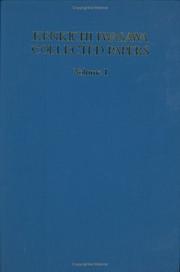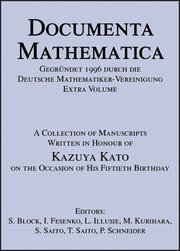| Listing 1 - 6 of 6 |
Sort by
|
Book
ISBN: 0691138214 1400837111 0691138222 9780691138220 9781400837113 9780691138213 Year: 2008 Publisher: Princeton, NJ
Abstract | Keywords | Export | Availability | Bookmark
 Loading...
Loading...Choose an application
- Reference Manager
- EndNote
- RefWorks (Direct export to RefWorks)
In 1970, Phillip Griffiths envisioned that points at infinity could be added to the classifying space D of polarized Hodge structures. In this book, Kazuya Kato and Sampei Usui realize this dream by creating a logarithmic Hodge theory. They use the logarithmic structures begun by Fontaine-Illusie to revive nilpotent orbits as a logarithmic Hodge structure. The book focuses on two principal topics. First, Kato and Usui construct the fine moduli space of polarized logarithmic Hodge structures with additional structures. Even for a Hermitian symmetric domain D, the present theory is a refinement of the toroidal compactifications by Mumford et al. For general D, fine moduli spaces may have slits caused by Griffiths transversality at the boundary and be no longer locally compact. Second, Kato and Usui construct eight enlargements of D and describe their relations by a fundamental diagram, where four of these enlargements live in the Hodge theoretic area and the other four live in the algebra-group theoretic area. These two areas are connected by a continuous map given by the SL(2)-orbit theorem of Cattani-Kaplan-Schmid. This diagram is used for the construction in the first topic.
Hodge theory. --- Logarithms. --- Logs (Logarithms) --- Algebra --- Complex manifolds --- Differentiable manifolds --- Geometry, Algebraic --- Homology theory --- Algebraic group. --- Algebraic variety. --- Analytic manifold. --- Analytic space. --- Annulus (mathematics). --- Arithmetic group. --- Atlas (topology). --- Canonical map. --- Classifying space. --- Coefficient. --- Cohomology. --- Compactification (mathematics). --- Complex manifold. --- Complex number. --- Congruence subgroup. --- Conjecture. --- Connected component (graph theory). --- Continuous function. --- Convex cone. --- Degeneracy (mathematics). --- Diagram (category theory). --- Differential form. --- Direct image functor. --- Divisor. --- Elliptic curve. --- Equivalence class. --- Existential quantification. --- Finite set. --- Functor. --- Geometry. --- Hodge structure. --- Homeomorphism. --- Homomorphism. --- Inverse function. --- Iwasawa decomposition. --- Local homeomorphism. --- Local ring. --- Local system. --- Logarithmic. --- Maximal compact subgroup. --- Modular curve. --- Modular form. --- Moduli space. --- Monodromy. --- Monoid. --- Morphism. --- Natural number. --- Nilpotent orbit. --- Nilpotent. --- Open problem. --- Open set. --- P-adic Hodge theory. --- P-adic number. --- Point at infinity. --- Proper morphism. --- Pullback (category theory). --- Quotient space (topology). --- Rational number. --- Relative interior. --- Ring (mathematics). --- Ring homomorphism. --- Scientific notation. --- Set (mathematics). --- Sheaf (mathematics). --- Smooth morphism. --- Special case. --- Strong topology. --- Subgroup. --- Subobject. --- Subset. --- Surjective function. --- Tangent bundle. --- Taylor series. --- Theorem. --- Topological space. --- Topology. --- Transversality (mathematics). --- Two-dimensional space. --- Vector bundle. --- Vector space. --- Weak topology.
Book
ISBN: 213039776X Year: 1986 Publisher: Bures-sur-Yvette Institut des hautes études scientifiques
Abstract | Keywords | Export | Availability | Bookmark
 Loading...
Loading...Choose an application
- Reference Manager
- EndNote
- RefWorks (Direct export to RefWorks)

ISBN: 4431703144 Year: 2001 Publisher: Tokyo Springer-Verlag
Abstract | Keywords | Export | Availability | Bookmark
 Loading...
Loading...Choose an application
- Reference Manager
- EndNote
- RefWorks (Direct export to RefWorks)
Book
ISBN: 3540571108 3540479090 9783540571100 Year: 1993 Volume: 1553 Publisher: Berlin Springer
Abstract | Keywords | Export | Availability | Bookmark
 Loading...
Loading...Choose an application
- Reference Manager
- EndNote
- RefWorks (Direct export to RefWorks)
Algebraic geometry --- Arithmetical algebraic geometry. --- 512.7 --- 51 --- Arithmetical algebraic geometry --- Algebraic geometry, Arithmetical --- Arithmetic algebraic geometry --- Diophantine geometry --- Geometry, Arithmetical algebraic --- Geometry, Diophantine --- Number theory --- Algebraic geometry. Commutative rings and algebras --- Mathematics --- 51 Mathematics --- 512.7 Algebraic geometry. Commutative rings and algebras --- Congresses

ISBN: 9783936609219 3936609217 Year: 2003 Publisher: [Bielefeld]: [Universitat Bielfeld],
Abstract | Keywords | Export | Availability | Bookmark
 Loading...
Loading...Choose an application
- Reference Manager
- EndNote
- RefWorks (Direct export to RefWorks)
Book
ISSN: 03031179 ISBN: 2856291155 2856291171 9782856291580 2856291589 Year: 2002 Publisher: Paris Société mathématique de France
Abstract | Keywords | Export | Availability | Bookmark
 Loading...
Loading...Choose an application
- Reference Manager
- EndNote
- RefWorks (Direct export to RefWorks)
| Listing 1 - 6 of 6 |
Sort by
|

 Search
Search Feedback
Feedback About UniCat
About UniCat  Help
Help News
News